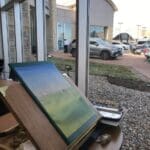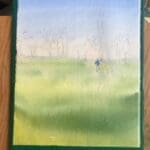The space we give our friends is part of how we enjoy friendship.
In this painting of me and my son, it’s the distance between us that makes room for this huge palm tree shadow.  Because we are further apart, I could see the shadow. If my son and I were in a three-legged race, I wouldn’t have seen the shadow. Sometimes our friends are impossible to enjoy because we are too close to see them properly. You can always read the Artist’s Note at my blog site (scroll down for mobile view, email readers go here) for backstory of my paintings.
Because we are further apart, I could see the shadow. If my son and I were in a three-legged race, I wouldn’t have seen the shadow. Sometimes our friends are impossible to enjoy because we are too close to see them properly. You can always read the Artist’s Note at my blog site (scroll down for mobile view, email readers go here) for backstory of my paintings.
For January, we are talking about expecting better friendships. In this last post, I want to offer some practical tips for downsizing a friendship and why it can make your friendships more beautiful. Downsizing a friendship can make it possible to enjoy this friend as they were meant to be in your life. Here’s a line from my journal that illustrates the need, maybe you’ve felt too,
“Is there a smaller box in my life that she can fit into?”
I wasn’t interested in abandoning the friendship. I wasn’t fed up. I was sorting.
I move friends around, sorting them into larger or smaller boxes depending on what they’ve revealed they can offer. Too often we get resentful that the friendship is just not working, so we either over-function or just give up. But the answer can be as simple as sorting our friendships.
Let me illustrate. Imagine a girl sitting on a picnic blanket. In front of her are a series of boxes. The larger boxes are closest to her, the smaller ones further away. She is moving friends. This moving from small to large, from large to medium, is exactly what sorting can feel like. And it doesn’t mean anyone is bad. Sorting just means you’re adjusting your expectations to reality.
So how do you know you need to work on sorting your friends into a smaller space? A few tell-tale signs.
- You’re more disappointed than pleased with some friends.
- Outside of your family, you cannot name more than one “fountain friend” over the last 10 years.
- You tend toward all-or-nothing thinking.
- You struggle with black-and-white expectations.
Let me unpack a few of these.
Those last two are signs you came from an addictive family of origin. I get that; I did, too. The drug of choice doesn’t have to be alcohol or prescription drugs. People can be addicted to a way of relating that is dysfunctional. If you come from a codependent family culture (find my series on codependency here), you will also struggle with all-or-nothing thinking: “She wasn’t there for me this time, so I cannot ever rely on her again.”
Codependent families paint the world in black-and-white simplicity. Sure, there are some black-and-whites in this world, but there are fewer than some of us were taught. For instance, “Don’t lie” must be nuanced by what this person has a right to know. Certainly we tell the truth, but I am not obligated to tell the whole truth to everyone. I can withhold, I can share cryptically. And I’m never obligated to tell the truth to evil people who will twist the truth. Both all-or-nothing and black-and-white thinking are childish ways to see the world, entirely appropriate for a six-year-old, but not for adult friendships.
All-or-nothing thinking creates all-or-nothing friendships where you put all your hopes into one friend then spiral when they cannot deliver on your expectations. All-or-nothing thinking is common in first romances as well. This is, inevitably, too much pressure for any friend. The box we chose is too big for them. We are repeatedly disappointed and often give up (all-or-nothing). Rather than dropping or cutting off, or ghosting (dropping all texting communication), we can change expectations. This is where sorting comes in.
Downsizing a friendship means you’re sorting friends into smaller boxes. If you can do this, you’re allowing more people to play more roles in your life, rather than expecting one or two friends to do it all. For example, if I expect E to keep up with my reading schedule, it will strain our emotional connection. So I rely on J to read with me, without also expecting her to be emotionally vulnerable. Sorting makes this possible. E is in a larger box closer to me, but not the only box close to me. And J is in a smaller box further from me, but still a friend. For more on my friendship with E and J see “Sorting Friends.”
If this sounds difficult, you may need some practical ways to start your downsizing conversations. If you need to move a friend from a larger to a smaller space, here are a few lines you can adapt:
- To slow down the pace of getting together, “I’ve got a lot on my plate right now, how about we look at (insert later date).” The date is important as it shows your friend you’re taking responsibility for maintaining connection.
- For a hard stop on how you interact, “I need to take inventory of how I’m spending my time. I’m not mad or hurt, I just need to figure some things out for myself.” Then you must reconnect, be it a month, 6 months, a year, with warmth and kindness. Downsizing always hurts, but reconnecting prevents you from destroying this friendship.
- To create appropriate distance when asked a personal question, “I’m still figuring that out.”
- To buy you time to think “That’s a good question, what do you think about it?”
These are all better responses than avoiding, blaming, over-whelming, cutting off, or ghosting a friend. They mean you’re staying engaged and kind instead of fed-up, judgmental or resorting to childish behavior. You can read more on making boundaries while maintaining connection in the book The Dance of Anger, by Herriot Learner. I highly recommend it.
Should you like some ideas for upsizing a friendship, please ask in the comments.

The Friendship Posts
Expecting Better Friendships: Friendship Fountain, Sorting Friendships, Downsizing Friendships
What is a Friend: Balloon Friends, Companions, It is Good You Exist
The Pace of Friendship: Walk with Me, Return the Volley, Trains and Rollercoasters
Growing Friendships: Friends and Flowers, Growing a Friendship, Weeding a Friendship
Healing a Friendship: Forgiveness, The Work of Healing, The Crucial Question












